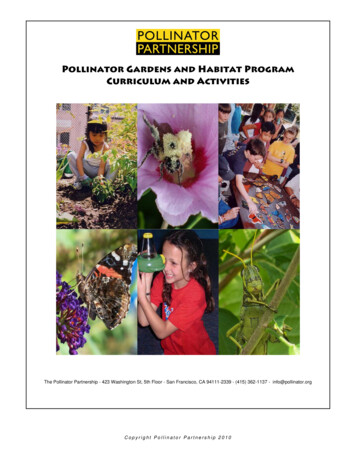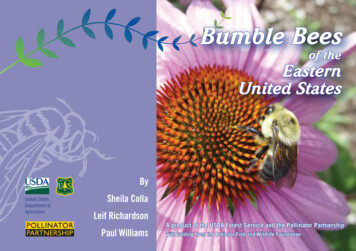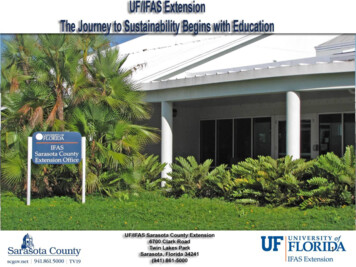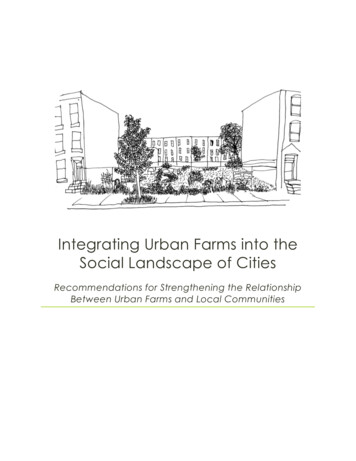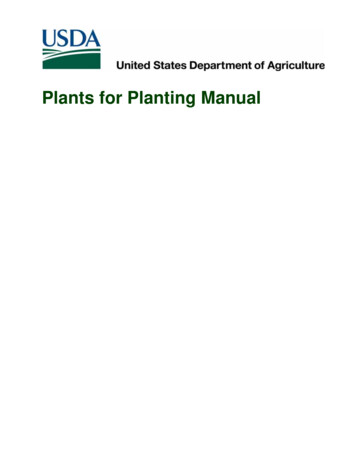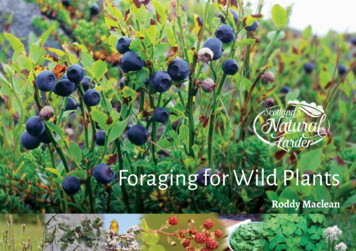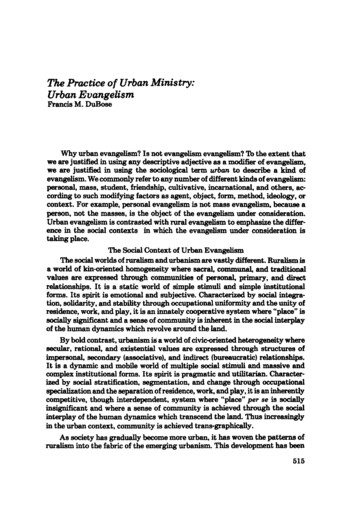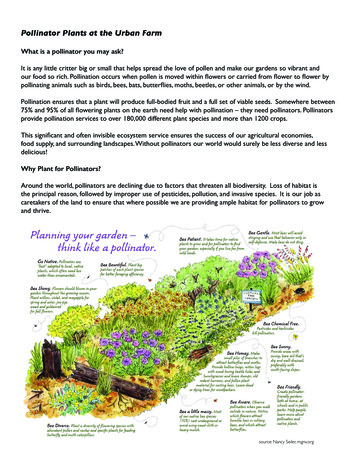
Transcription
Pollinator Plants at the Urban FarmWhat is a pollinator you may ask?It is any little critter big or small that helps spread the love of pollen and make our gardens so vibrant andour food so rich. Pollination occurs when pollen is moved within flowers or carried from flower to flower bypollinating animals such as birds, bees, bats, butterflies, moths, beetles, or other animals, or by the wind.Pollination ensures that a plant will produce full-bodied fruit and a full set of viable seeds. Somewhere between75% and 95% of all flowering plants on the earth need help with pollination – they need pollinators. Pollinatorsprovide pollination services to over 180,000 different plant species and more than 1200 crops.This significant and often invisible ecosystem service ensures the success of our agricultural economies,food supply, and surrounding landscapes. Without pollinators our world would surely be less diverse and lessdelicious!Why Plant for Pollinators?Around the world, pollinators are declining due to factors that threaten all biodiversity. Loss of habitat isthe principal reason, followed by improper use of pesticides, pollution, and invasive species. It is our job ascaretakers of the land to ensure that where possible we are providing ample habitat for pollinators to growand thrive.source: Nancy Seiler, mgnv.org
What To Plant and WhyNative plants are adapted to the local climate and soil conditions where they naturallyoccur. A diversity of native flowering plants in your garden will provide a wonderful habitatfor a large variety of native pollinators and may even provide you with a tasty treat toeat at the end! Plant any of these following plants in your garden and you are sure have asymphony of pollinators visit come spring.Thyme Thymus mongolicusThyme is a perennial herb that does best in average soilsSun: Partial ShadeSize: 1’ tallSpecies: butterfliesBonus: It’s a tasty kitchen herblocal suppliers:source: thespruce.comRed and Yellow Columbine Aquilegia formosaRed and Yellow Columbine is a perennial forb that prefers averagesoil moisture to grow in.Sun: Full or PartialSize: 5’ tall and about 2’ wide.Species: humming birds, butterflies, and native beeslocal suppliers: Doak Creek Nurserysource: redrockcanyonlv.orgLarge Leafed Lupine Lupinus polyphyllus var. polyphyllusLarge-leaved Lupine is a perennial forb that prefers damp soil.Sun: FullSize: 4’ tall and about 4’ wide.Species: humming birds, butterflies, and native beesBonus: host plant for butterflies!local suppliers: Doak Creek Nurserysource: superiorfootprints.orgOrange Flowered Honeysuckle Lonicera ciliosaOrange-flowered Honeysuckle is a perennial forb that can survive inaverage soil types. This plant is a climber and will do well on a fence,trellis, archway or tall shrub so it can grow upwards and sidewaysSun: Full or PartialSize: 4’ tall and about 4’ wide.Species: humming birds, butterflies, and native beeslocal suppliers:source: rhs.org
Western Trillium Trillium ovatum ssp. ovatumWestern Trillum is a perennial forb that can survive in average soiltypes.Sun: Full or Partial ShadeSize: 1’ and about 1’ wideSpecies: native beeslocal suppliers: Doak Creek Nurserysource: davidmacleodphotography.comYarrow Achillea millefoliumYarrow is a perennial forb that can live in average soil types.Sun: FullSize: 3’ tallSpecies: butterflies and native beeslocal suppliers: Doak Creek Nurserysource: learningherbs.comWestern Goldenrod Solidago lepida var. salebrosaWestern Goldenrod is a perennial plant that is commonly foundin meadows and prairies. It grows best in moderate to welldrained soils.Sun: FullSize: 3-6.5’ tallSpecies: nectar for butterflies and habitat and foraging grounds forother polliantorsBonus: Drought Tolerant!local suppliers:source: flickriver.comOregon Sunshine Eriophyllum lanatumOregon Sunshine is a perennial forb that prefers dry soil. It isvery showy and great for landscape use.Sun: FullSize: 3’ tallSpecies: butterflies and native beesBonus: Drought Tolerant!local suppliers:source: lhseeds.comPearly Everlasting Anaphalis margaritaeaPearly Everlasting is a perennial forb that prefers dry, sandy orgravelly soil. It has a long bloom time and is easy to care for.Sun: Partial ShadeSize: 3’ tallSpecies: butterflieslocal suppliers: Doak Creek Nurserysource: bentonswcd.org
Douglas Aster Symphyotrichum subspicatumDouglas Aster is a perennial forb that requires moist soil. It has alate bloom time with showy violet-colored flowersSun: FullSize: 3’Species: native bees and butterfliesBonus: it is a host plant for certain butterflieslocal suppliers: Doak Creek Nurserysource: gordanahabitat.comRosemary Rosamarinus officinalisRosemary is a perennial forb that grows in a semi-erect shape.Sun: FullSize: 5’ tallSpecies: native beesBonus: Drought Tolerantlocal suppliers:source: learningherbs.comEnglish Lavender Lavender angustifoliaEnglish Lavender is an annual forb that prefers light soilSun: FullSize: 3’ tallSpecies: native beesBonus: Very Fragrant!local suppliers:source: hgtv.comBlanket Flower Gaillardia grandifloraBlanket Flower is a hybridized perennial that grows in welldrained soils and has a long bloom period.Sun: FullSize: 3’ tallSpecies: birds and butterfliesBonus: low maitenancelocal suppliers:source: gardenia.netCommon Sunflower Helianthus annuusCommon Sunflower grows best in soil consisting of dry clay orheavy sand and needs a medium amount of water.Sun: Full SunSize: 1.5-8’ tallSpecies: birds and beeslocal suppliers:source: uniprot.org
California Poppy Eschscholzia californicaCalifornia Poppy is a perennial that grows best in dry soil.Sun: Full SunSize: 1’ tallSpecies: mainly bumble-beeslocal suppliers:source: gardeningknowhow.comShowy Milkweed Asclepias speciosaShowy Milkweed is a perennial that grows best in moist soil.Sun: FullSize: 1.5-3’ tallSpecies: hummingbrids and butterfliesBonus: Monarch Butterfly host plantlocal suppliers: Doak Creek Nurserysource: davesgarden.comMad Dog Skull Cap Scutellaria laterifloraMad Dog Skull Cap is a perennial that grows best in moistconditionsSun: Full Sun to Light ShadeSize: 1-2.5’’ tallSpecies: native beeslocal suppliers:source: pinterest.comRed Flowering Currant Ribes sanguineumRed-Flowering Currant is a shrub that grows best in moist todrier soil.Sun: Sun or ShadeSize: 6-12’ tallSpecies: hummingbirds, butterflies, beeslocal suppliers: Doak Creek Nurserysource: hilaryscott.co.ukPacific Hound’s tongue Cynoglossum grandePacific Hound’s tongue is a perennial growing best in moist soil.Sun: small clearing with some sun but is shade tolerantSize: 1-2.5’ tallSpecies: early native beeslocal suppliers:source: nwwildflowers.com
Tall Oregon Grape Mahonia (Berberis) aquifoliumTall Oregon Grape typically grows on dry or wet areas and hasslightly prickly leaves.Sun: shade or sunSize: 8’ tallSpecies: birds, butterflies, beesBonus: Drought Tolerantlocal suppliers: Doak Creek Nurserysource: portlandnursery.comTri-Color Sage Salvia officinalis var. tricolorTri-color Sage is a perennial evergreen shrub that grows best inwell-drained soil.Sun: FullSize: 3’ tallSpecies: butterfliesBonus: deer resistantlocal suppliers:source: yourgardenparty.comWoods Strawberry Fragaria vesca ssp. bracteataWoods Strawberry is a perennial herb that does best inaverage soils.Sun: Partial SahdeSize: 6’’ tallSpecies: bees and butterfliesBonus: The fruit is edible and it is a host plant for certain butterflieslocal suppliers: Doak Creek Nurserysource: fourthcornernurseries.comOregano Origanum vulgareOregano is a perennial that flourishes in dry to well-drained soilto flourish.Sun: Full SunSize: 1-2’ tallSpecies: host plant for pollinator insects such as lacewingsBonus: It’s a tasty kitchen herb!local suppliers:source: elcorreodelsol.comChives Allium schoenoprasumThe Chive is a perennial herb that does best in average soils.Sun: Partial ShadeSize: 1-2.’ tallSpecies: bees and hummingbirdsBonus: It’s a kitchen herb that repels insect pests in the garden.local suppliers:source: nwwildflowers.com
It is any little critter big or small that helps spread the love of pollen and make our gardens so vibrant and our food so rich. Pollination occurs when pollen is moved within flowers or carried from flower to flower by pollinating animals such as birds, bees, bats, butte
